27 Types Of Guava Trees: History, Varieties, And More (Identification Guide)
Guavas are a diverse tropical fruit that captivate many with their unique flavors and histories. With over 20 varieties, each has its own distinct characteristics and story to tell. In this article, we’ll delve into the different types of guavas and explore their fascinating histories. We’ll also provide valuable tips on selecting the perfect guava tree for your home garden.
What is guava?
Guavas are a type of tropical fruit native to Central America, boasting an impressive array of nutritional benefits. Notably, they are an excellent source of Vitamin C, with a distinctive flavor profile that perfectly balances sweetness and tartness. This versatility lends itself well to being enjoyed fresh or utilized in various culinary applications, such as juices, jams, and pies.
As a staple in many tropical nations, guavas have slowly begun to gain traction in the United States, where their unique characteristics are increasingly winning over local palates.
History of guava trees.
Guava trees have a rich history of cultivation that dates back centuries. Their native habitat is in tropical America and the West Indies, where they’ve been nurtured for generations. The first recorded instances of guava tree cultivation in Florida emerged in the 18th century, while introduction to Hawaiian soil took place in the 19th century. Over time, this versatile fruit has spread to many tropical and subtropical regions worldwide, solidifying its position as a prominent global crop.
Guava Characteristics.
Native to the Caribbean, Central America, and South America, the evergreen guava shrub or small tree produces fruit that’s enjoyed fresh or transformed into juices, jams, and jellies. Rich in vitamin C and fiber, this fruit boasts an impressive nutritional profile. The guava tree is remarkably diverse, with various cultivars exhibiting distinct shapes – round or oval – and hues – green, yellow, red, or maroon.
The flesh can be white, pink, or red, while the small, edible seeds add a delightful crunch to the experience. When savored, guavas offer a sweet yet tangy flavor profile reminiscent of a strawberry-pear hybrid. As an added bonus, they’re a rich source of vitamins A, C, and B. With their versatility in being consumed fresh, cooked, or juiced, guavas are an accessible and enjoyable fruit.
When selecting a guava, look for one that’s firm and free from bruising; store them in the refrigerator for up to two weeks for optimal freshness.
How to identify guava.
Guavas can be distinguished through their distinct physical characteristics. Their shape, for instance, is usually rounded or oval and the skin may appear green, yellow, or even red. Furthermore, the flesh of the fruit can be white, pink, or red, featuring small seeds as well. In addition to visual identification, guavas are also known for their unique flavor profile. Characterized by a sweet taste with hints of acidity, this fruit is often used in desserts or enjoyed raw as a snack.
Types of Guava.
While there’s a wide variety of guava species out there, several stand out as being the most widely recognized and cultivated. At the top of this list are the ones that share some distinct characteristics.
Arka Mridula guava.
Arka Mridula guava, a tropical fruit originating from India, boasts an oval shape with a green exterior and white flesh speckled with small seeds. Its sweet and tangy taste profile is a distinguishing feature of this unique variety. The tree itself reaches heights of 20 feet, boasting a lifespan of approximately 15 years. Notably, the Arka Mridula guava tree exhibits robust resistance to pests and diseases, ensuring its cultivation and longevity.
In Ayurvedic medicine, the fruit is prized for its medicinal properties, which are believed to alleviate symptoms of common ailments like diarrhea, constipation, and indigestion.
Banarasi guava.

The Banarasi guava is a type of guava native to the Indian subcontinent, commonly grown in the city of Varanasi. Characterized by its small, round shape with green skin and white flesh, this fruit boasts a sweet, aromatic flavor that’s often used in Hindu religious ceremonies. Its unique taste profile is described as a harmonious blend between strawberry and pear. In India, it’s a popular cultivar for making juices, jams, and jellies, while also being enjoyed fresh in salads or as a raw snack.
The fruit’s nutritional profile is impressive, providing vitamins C and A, along with essential fiber, potassium, and magnesium content. When consumed, the Banarasi guava can be eaten raw, cooked, or juiced, making it a versatile and healthy addition to one’s diet.
Beaumont Guava.
The Beaumont guava is a fascinating fruit that boasts a unique profile. Its round shape and vibrant green exterior give way to a pink-fleshed interior, reminiscent of a tennis ball. This tropical gem hails from South America, Central America, and the Caribbean, where it thrives in warm climates. Beyond its striking appearance, the Beaumont guava is a nutritional powerhouse, rich in vitamins C and A as well as fiber.
Enjoy it fresh or get creative with jams, jellies, and pies – the possibilities are endless! Interestingly, this flavorful fruit gets its name from Beaumont, Texas, where it was first cultivated in the United States.
Brazilian Guava.
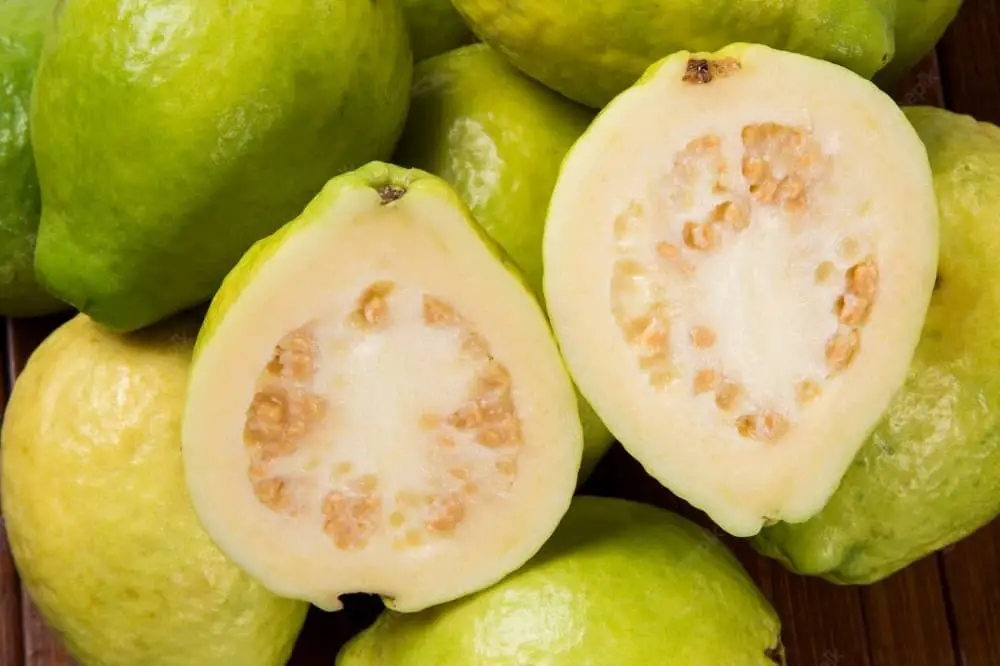
The enigmatic Brazilian guava is a fruit that thrives on the Psidium guajava tree, its scientific name a testament to its unique identity. Native to tropical and subtropical regions worldwide, Brazil takes pride as one of the leading producers of this delectable fruit, its bounty reflecting the country’s rich cultural heritage.
Cherry Guava.

Cherry guava is a fascinating fruit that originates from Brazil, where it grows on the Psidium littorale shrub. This succulent has a distinctive appearance, featuring a rounded or oval shape roughly equivalent to the size of a chicken egg. Its outer layer boasts a thin, yellow-green hue with small, red bumps scattered across its surface. The inner flesh is either white or pink and offers a delightful combination of sweet and tart flavors.
Fresh consumption or incorporation into jams, jellies, and pies are both viable options for enjoying this fruit. As a member of the myrtle family, cherry guava shares lineage with eucalyptus, feijoa, allspice, and clove. Its introduction to Hawaii in the late 1800s has led to widespread cultivation across all the Hawaiian Islands, as well as in California, Florida, and Puerto Rico.
Chittidar guava.
Chittidar guava is a tropical treasure hailing from Mexico, Central America, and the Caribbean, where it thrives in the warm climate of its native myrtle family. Its rounded or oval shape belies a smooth, yellowish-green exterior that yields to a refreshing interior – a soft white or pink flesh speckled with small, black seeds.
This versatile fruit can be savored on its own as a sweet treat, transformed into vibrant juices, jams, and jellies, or infused into creamy ice cream, tangy yogurt, and other indulgent desserts.
Costa Rican guava.
Costa Rican guava is a tropical treasure that hails from the sun-kissed island of Costa Rica. This small, round fruit boasts a vibrant greenish-yellow skin that gives way to a delicate pink flesh. Its flavor profile is a perfect balance of sweet and acidic, making it an ideal ingredient for jams, jellies, and pies. As part of the Myrtaceae family, which also comprises cloves, allspice, and eucalyptus, the Costa Rican guava tree is native to Central America and Mexico.
However, its popularity has led to introductions in various other regions, including the Caribbean, South America, and Florida.
Detwiler guava.
Detwiler guava, a tropical fruit native to Central America, boasts an unique profile. Its spherical or oval shape is complemented by a thin, yellow-green skin that gradually yields to a pink or white flesh, speckled with small, black seeds. The flavor profile mirrors that of other guavas, offering a sweet and slightly acidic taste experience. The fruit’s name is a nod to American botanist David Fairchild Detwiler, who introduced it to the United States in the early 1900s.
Although not as widely cultivated as other types of guavas, Detwiler guava can be found in tropical areas of the Americas, including Florida, Puerto Rico, and Hawaii, where its distinctive characteristics have earned a place among the region’s diverse fruit offerings.
Giant Vietnamese guava.
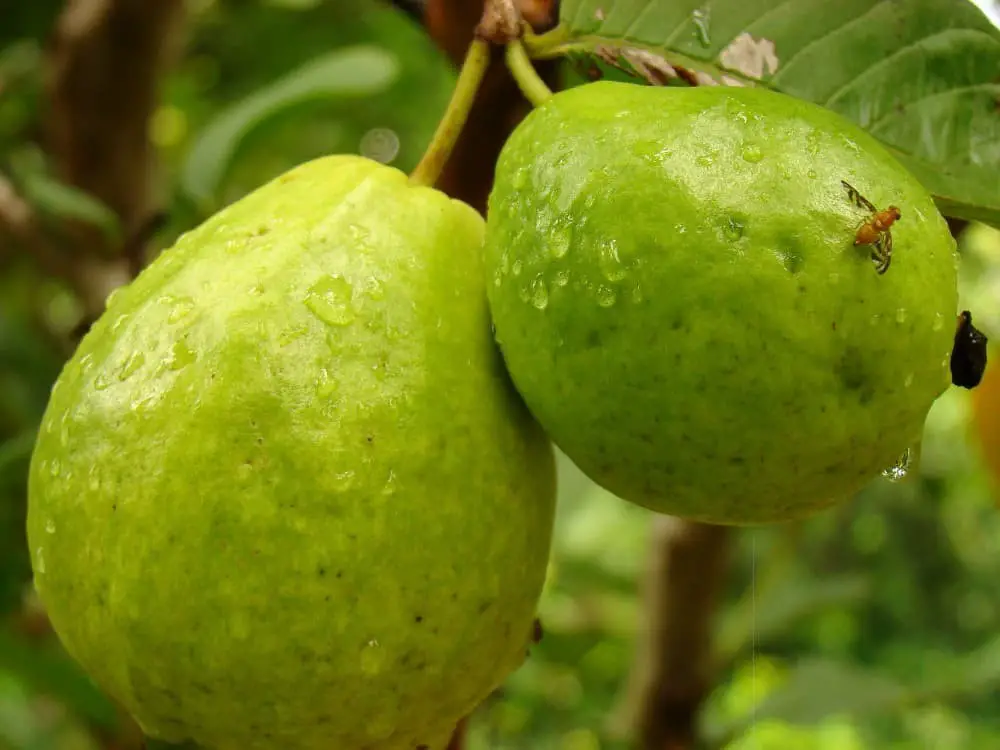
Giant Vietnamese guava is a fascinating and unique fruit that hails from its namesake country, Vietnam. This large fruit, which can grow to the size of a watermelon, boasts a white pulp filled with seeds. Not only is it edible, but it can be consumed in two ways: raw or cooked. While the trees themselves are not as common in the United States, they do offer a delicious and exotic treat for those who have access to them.
Harijha guava.
The giant Harijha guava is a notable specimen, boasting a weight of over two pounds, making it the world’s largest guava by far. Indigenous to the Indian subcontinent, this tropical fruit has spread its popularity globally. Its vibrant green exterior gives way to white flesh, offering a sweet flavor profile with a subtle tanginess. Notably, Harijha guava is an excellent source of vitamins C and A, as well as dietary fiber, making it a nutritious addition to one’s diet.
Enjoyed fresh or incorporated into jams, jellies, and other recipes, this fruit is a versatile delight.
Homestead guava.
Giant Homestead Guava, a tropical fruit that can weigh up to two pounds, boasts a unique combination of greenish-yellow skin and pink flesh. Native to Southeast Asia, but also found in South America and India, this remarkable fruit has adapted to thrive in various regions.
The tree itself can reach heights of 30 feet or more, with leaves used to create a soothing tea. Its fruit is a versatile ingredient, commonly used in jams, jellies, and pies.
Notably, Guava is an excellent source of vitamins C and A, as well as fiber and potassium.
Enjoyed fresh, made into juice, or dried for use as powder or flakes, Giant Homestead Guava offers a wide range of consumption options. Its nutritional profile makes it a great addition to a healthy diet.
Hong Kong Pink Guava.
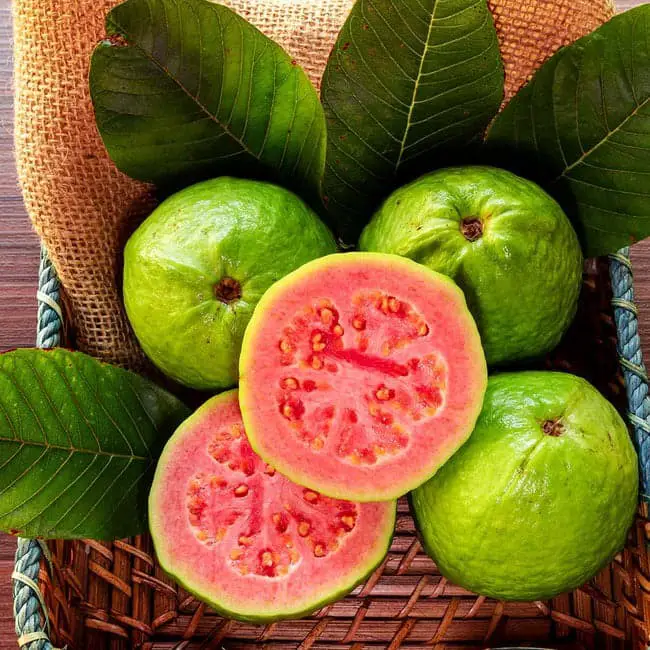
In the lush landscapes of Southeast Asia, a prized fruit has been thriving for centuries. Meet the Hong Kong pink guava, a small but mighty fruit that packs a big punch. Its thin skin encases a multitude of tiny seeds, surrounded by a sweet and succulent flesh that’s either white or yellow in hue. This delightful treat is a staple in Asian cuisine, enjoyed fresh, cooked, or transformed into delectable preserves, beverages, and more.
Lemon Guava.
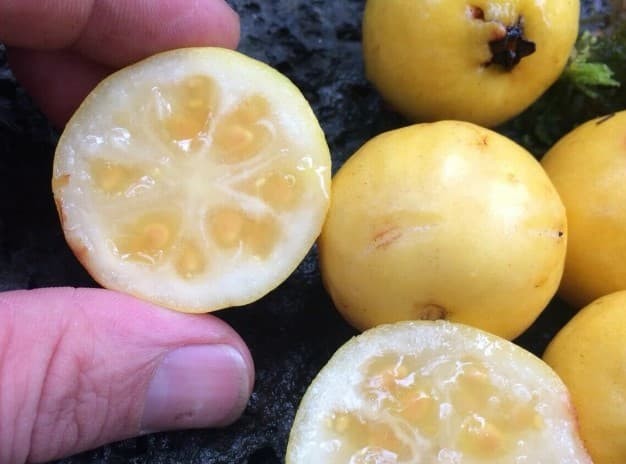
Lemon guava is a tropical fruit that bears a striking resemblance to pears in terms of its shape. Its outer layer features a yellow-green hue, while the interior boasts juicy white flesh punctuated by seeds. Originating from Brazil, this fruit has since been cultivated in numerous tropical nations worldwide.
This citrusy treat is an exceptional source of vitamin C, boasting more than twice the amount found in a single orange.
Furthermore, lemon guava is a rich provider of dietary fiber and antioxidants.
As a versatile ingredient, lemon guava can be savored fresh or transformed into a variety of sweet treats like jams, jellies, and preserves. Its popularity also extends to tropical drinks and desserts, making it a sought-after addition in many culinary creations.
Mexican Cream Guava.

Native to Mexico, Mexican cream guava is a unique variety of guava that stands out with its distinctive characteristics. Its thin, white skin gives way to pale pink or white flesh, boasting a sweet flavor profile reminiscent of strawberry-kiwi fusion. Enjoyed fresh and often used in various desserts like jams and jellies, this flavorful fruit offers a delicious addition to any culinary experience.
Mountain Guava.
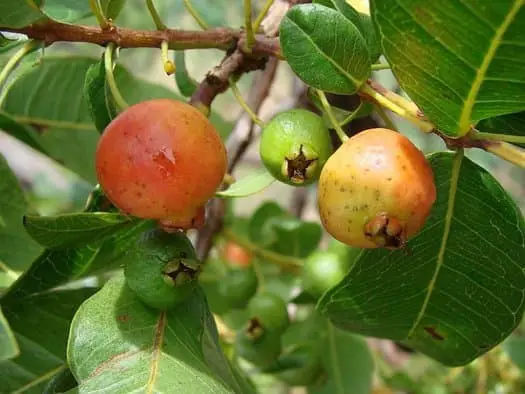
Pineapple Guava.
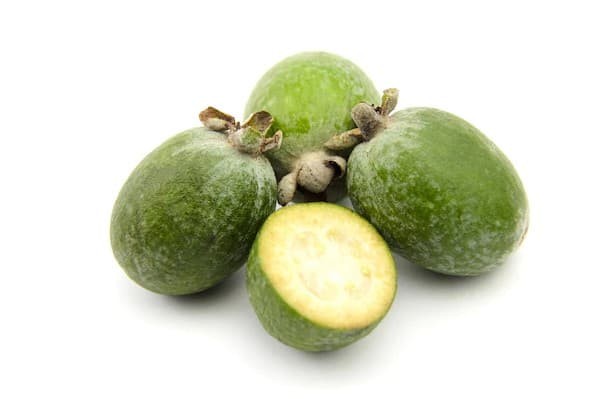
Pineapple guava is a tropical delight hailing from Brazil, where it’s cultivated as a native fruit. Its appearance is characterized by a rounded or oval shape, with a greenish-yellow skin that gives way to white or pink flesh boasting a sweet, pineapple-inspired flavor profile. The tree itself can grow up to 20 feet tall, sporting dark green, glossy leaves that add to its tropical charm.
As the seasons change, the pineapple guava tree awakens in springtime, showering the landscape with clusters of white or pink flowers. This fruit is deeply ingrained in Brazilian culture, frequently featured in refreshing juices, sweet jams, and mouthwatering pies.
Pyramidal Shaped Guava.
Pyramidal shaped guavas get their name from their unique pyramid-like appearance. Characterized by a thin, smooth skin that transitions from green to yellow hues, this fruit’s exterior belies its creamy white or pink flesh, replete with tiny seeds. A notable characteristic is the smaller size of pyramidal shaped guavas compared to other varieties.
Red Indian Guava.
Red Indian Guava is a tropical fruit hailing from India and Pakistan, where it thrives as an evergreen tree that can grow up to 20 feet tall. Its leaves are a deep green hue with a glossy, leathery texture, while the white flowers with purple centers bloom in clusters. The fruit itself is oval-shaped, about the size of a lemon, and has a thin, smooth skin that’s essential to consume due to its high fiber content.
When you do bite into it, you’ll discover a juicy, sweet flesh with a slightly acidic taste, making it perfect for blending into juices, jams, or desserts.
Red Malaysian Guava.
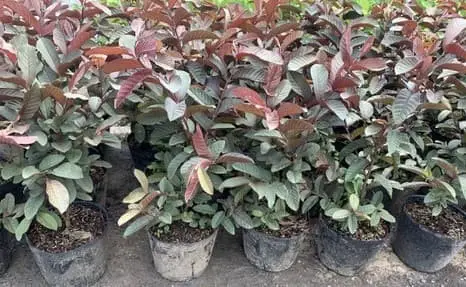
Red Malaysian guava, a tropical fruit native to Malaysia, boasts a unique appearance. Its small, round shape is characterized by a vibrant red skin, giving way to white flesh with a tantalizing sweet-tart flavor profile. This versatile fruit is frequently utilized in juices and jams, capitalizing on its natural sweetness.
In terms of cultivation, the Red Malaysian Guava tree reaches an average height of 20 feet, producing small, golf ball-sized fruits that are scattered among its evergreen foliage. As an evergreen species, it thrives in tropical climates globally.
Round Guava.
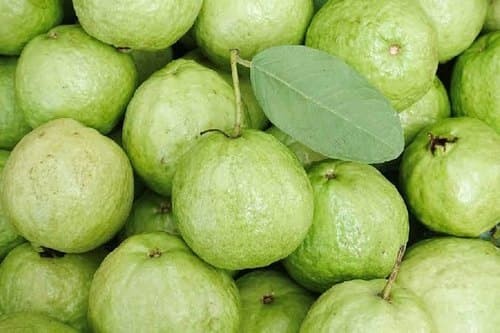
Guavas, specifically the round variety, are a type of fruit that thrives on guava trees. Originally hailing from Central America, these trees have since been cultivated in numerous tropical regions around the world. Characterized by their compact size and rounded shape, round guavas boast a green exterior and a snowy white interior. When ripe, they possess a sweet and tantalizing flavor profile, often making them a popular choice for desserts or snacking fresh.
Ruby-X Guava.
Ruby-X Guava, a tropical fruit from the myrtle family, is a staple in Taiwan’s culinary scene. Its sweet and tangy taste, often likened to a strawberry-grapefruit fusion, makes it a popular choice for juices, jams, and jellies. The name ‘ruby-X guava’ originates from its characteristic red hue, although the fruit can also appear pink or white depending on the ripeness. Native to Taiwan, Ruby-X Guava was introduced to Hawaii in 1825, where it has thrived as a versatile ingredient.
The evergreen shrub that bears this fruit grows up to 15 feet tall, with dark green leaves featuring a leathery texture and five-petaled white flowers adding to its allure.
Strawberry Guava (Cattley).
Strawberry guava, scientifically known as Psidium cattleianum, is a diminutive tree or shrub that yields a delectable fruit. Characterized by its spherical or oval shape, the fruit’s outer layer can range in color from vibrant red to deep purple. Beneath this colorful exterior lies a fleshy interior that can be either white, pink, or a fiery red hue, accompanied by tiny seeds.
When ripe, the fruit’s sweetness is reminiscent of its namesake, strawberry, making it a popular choice for crafting jams, jellies, and succulent sauces.
Sweet White Indonesian Guava.
Indonesian sweet white guava, a native species to the country, has garnered immense popularity among locals. Its small, round fruit is characterized by its sweet and slightly tart white flesh. While it’s often enjoyed fresh, this versatile variety also lends itself well to culinary applications like juices, jams, and pies, making it a staple in many Indonesian desserts and snacks.
Thai Maroon Guava.
In the realm of tropical delights, the Thai Maroon guava (Psidium littorale var. Longispinum) stands out for its unique characteristics. Hailing from Thailand, this variety boasts a compact, rounded appearance with vibrant red skin giving way to crisp white flesh. The taste experience is equally intriguing, offering a balance of sweetness and subtle acidity, subtly underscored by hints of warm cinnamon.
As a staple in Thai cuisine, the Thai Maroon guava can be enjoyed fresh or cooked into a variety of dishes. Moreover, its versatility extends to the realm of preserves, as it can be transformed into luscious jams and jellies.
Tropical White Guava.
Tropical white guava, a small, round fruit native to Puerto Rico, boasts a unique appearance: its flesh is white, while the skin has a pinkish-white hue. The flavor profile is characterized by sweetness with a hint of acidity. This versatile fruit finds its way into various products like juices, jams, and jellies, but it’s also enjoyed fresh or brewed as a refreshing tea.
In addition to its delectable taste, tropical white guava stands out for its impressive nutritional profile.
It is an excellent source of essential vitamins and minerals, including Vitamin C, which plays a crucial role in immune system function. The fruit also contains fiber, potassium, and magnesium, making it a nutritious addition to any diet.
White Indian guava.
White Indian guava, a tropical fruit endemic to India, boasts a unique characteristic – its white coloration. When consumed fresh, it’s renowned for its sweetness, but it also lends itself well to being preserved as jams and jellies. The tree that bears this fruit can grow up to 20 feet tall, featuring dark green leaves and white flowers. Notably, the fruit itself is roughly the size of a tennis ball.
Wild Guava.
Wild guava, scientifically known as Psidium guajava, is a tropical fruit that boasts a unique flavor profile. While it shares some similarities with the common guava found in stores, it’s a distinct species with its own set of characteristics. For instance, wild guavas are smaller and pack a more intense flavor punch compared to their commercial counterparts.
How to care for guava.
Guavas are tropical plants that naturally thrive in warm, humid climates. They can be grown in containers or directly in the ground, requiring well-drained soil to flourish. One of their best qualities is being relatively low-maintenance, needing only occasional watering when the soil feels dry to the touch. In terms of nutrition, guavas benefit from regular fertilization every two months using a balanced fertilizer, and annual pruning to maintain their shape.
For optimal fruiting, guavas require full sun, but can adapt to partial shade if necessary. Harvest your ripe guavas between late summer and early fall, then enjoy them fresh, in preserves or baked into pies.
Conclusion
When it comes to selecting a guava tree, there are numerous options to consider. Rather than settling for just any variety, take the time to research the different types of guava trees available, taking into account your specific needs and preferences. By doing so, you’ll be able to find the perfect tree that will provide you with the desired fruit quality and yield. And as a reward, get ready to indulge in the sweet and tangy flavors of freshly harvested guavas!
Related Posts
Discovering the vast array of plants available online can be an exciting experience. From the classic apple trees to lush evergreens, there’s a variety of options to suit every taste. But have you considered pursuing a career in tree care? Our guide will walk you through the process of becoming an arborist, and explore the impact that trees can have on your property. And for those who want to get their hands dirty, we’ve also included tips on growing organic blueberry plants.
Meanwhile, removing certain types of trees can actually boost your home’s appeal. We’ll delve into the world of lady palms, exploring how to care for and grow these elegant plants.






